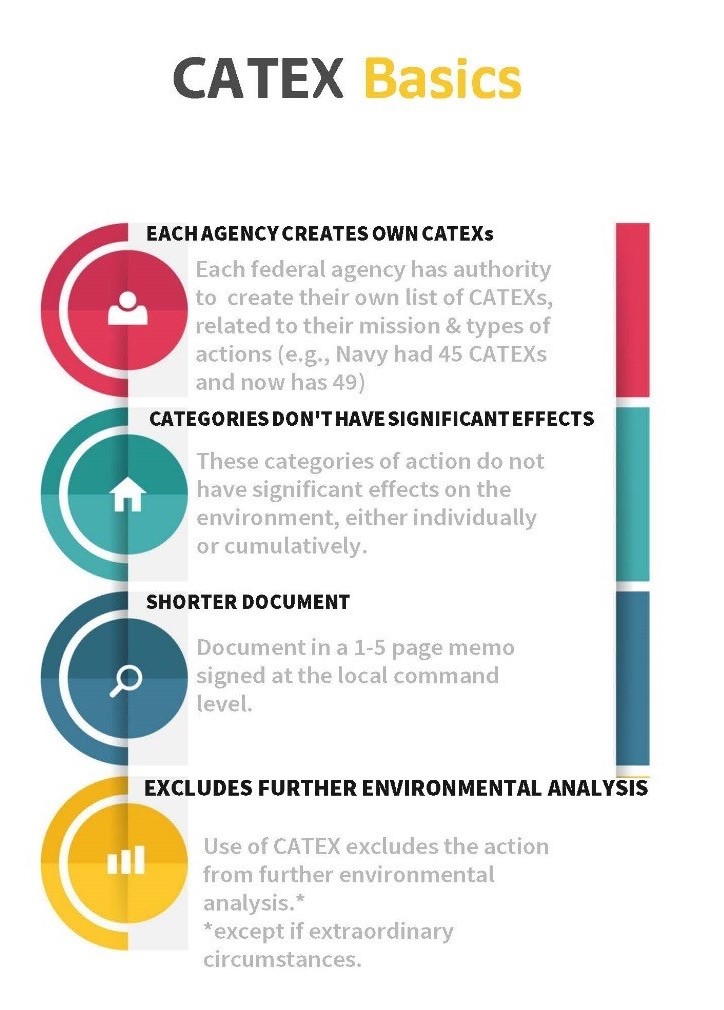On January 6, 2020, the Department of the Navy revised NEPA regulations went into effect. These changes focused on revising the Navy/Marine Corps classes of action or “categorical exclusions” to streamline the NEPA process. Categorical exclusions (also referred as CEs, CATEXs or CXs) are for proposed actions that normally would not result in significant environmental impacts. This can be a significant time- and money-saver and can make the difference between a 1 to 5-page CATEX document versus a 50+ page Environmental Assessment. This article summarizes the Navy/Marine Corps CATEX changes and how these changes might be of interest to other federal agencies.
1. Expands use of CATEXs where there are extraordinary circumstances.
Extraordinary circumstances are those which the Navy/Marine Corps has determined may require further environmental analysis because an action may have significant environmental effects.
Up to this point, if a proposed Navy/Marine Corps action would ordinarily fall under a CATEX but any of the extraordinary circumstances were present, the proposed action would be automatically “kicked out” of being eligible for a CATEX and would require a more lengthy Environmental Assessment or Environmental Impact Statement.
Before the new changes, examples of extraordinary circumstances that would automatically “kick out” a proposed action from using CATEXs included:
- Affects public health or safety
- Uncertain risks, scientific controversy
- Establishes a precedent for future actions
- May violate a local, state or federal environmental law or requirement
- May have significant impacts on: federally listed endangered/threatened species or marine mammals; coral reefs or federally designated wilderness areas or refuges; wetlands; cultural resources; hazardous waste sites or certain Clean Air Act issues.
An example of a real-world challenge with the “kick-out clauses” is a Marine Corps base that has numerous ranges that require recurring maintenance and repair of training areas and systems that support current training levels. These are the types of repairs that ordinarily may not have environmental effects. But if the proposed action has the potential to be in an area near endangered/threatened species, the action would be “kicked out” of being eligible for a CATEX, with no further opportunity to assess the context and intensity, and would require the preparation of multiple stand-alone Environmental Assessments.
The Navy recognized this challenge and answered the need for a faster, yet environmentally responsible process.
Clarifies extraordinary circumstances and adds a new process for approval. The 
For example, previous language stated that a CATEX could not be used if the proposed action would involve an action that may have an adverse effect on federally listed endangered/threatened species. Now the language states that before applying a CATEX, the decision-maker must consider whether individually or cumulatively an action may “have more than an insignificant or discountable effect on federally protected species.”
The Navy/Marine Corps also added the following process to allow decision makers more discretion in applying CATEXs:
- The presence of one or more extraordinary circumstances doesn’t automatically preclude CATEXs.
- When determining whether a CATEX is appropriate, focus on:
- Action’s potential effects;
- Consider environmental significance in terms of context & intensity.
- If you use a CATEX where one or more extraordinary circumstances are present, it must be forwarded to Navy or Marine Corps headquarters before the action is implemented.*
*Pre-approval requirement ends January 6, 2022, except for potential impacts under Endangered Species Act or Marine Mammal Protection Act. 32 CFR 775.6 e (2).
2. Revises six CATEXs.
The Navy/Marine Corps regulations also substantively revise six current CATEXs in the following areas:
- Routine repair and maintenance of buildings, facilities, etc. to add an example of general building/structural repair, landscaping, or grounds maintenance to clarify the types of activities covered. This revision does not cover the conversion to a new range capability or a change in the use of the range. (CATEX #8)
- Routine movement of mobile assets by expanding the types of mobile assets that could be considered and clarifying where no new support facilities are required. Specifically, the term “home basing” was added to provide the appropriate terminology for aircraft or ground asset reassignment not covered by the term “home porting” which is only in reference to ship or vessel reassignments. (CATEX #11)
- Alterations of and additions to existing buildings to combine with another CATEX and expand the examples of alterations such as runways that could be considered. (combined old CATEX #14 and 15, new CATEX #14)
- Real estate grants involving existing facilities or land with no significant change in use, revised slightly to clarify initial real estate in grants and outgrants but not renewals because renewals are covered by another CATEX. (old CATEX #32, new CATEX #29)
- New construction that is similar to or compatible with existing land use, added language to clarify actions are consistent with those of existing adjacent or nearby facilities. In the proposed rule, it stated that the test for whether this CATEX can be applied should focus on whether the proposed action generally fits within the designated land use of the proposed site. (old CATEX #34, new CATEX #33)
- Acquisition, installation, or operation of utility and communication systems, added language to apply to the modernization and repair of these systems as well. The Department of Navy felt it was important to include these terms to support energy resilience, alternative energy, and renewable energy projects given the Navy/Marine Corps emphasis on energy management throughout the Department. (old CATEX #36, new CATEX #35)
These revisions will provide Navy/Marine Corps environmental planners more flexibility in using CATEXs for routine and low-potential impact activities.
3. Creates five new CATEXs.
The Navy/Marine Corps created five new CATEXs to allow more flexibility with proposed actions such as natural resources management actions and minor repairs in response to natural disasters. These new CATEXs will help to address a variety of actions that normally do not require additional NEPA analysis.
A good example where one of these CATEXs could help to streamline the Navy NEPA process for repairs due to natural disasters is the recent damage sustained at Naval Air Weapons Station China Lake, CA, due to the 2019 earthquakes. The base is the Navy’s largest single landholding with over 1.1 million acres (larger than the state of Rhode Island) and represents 85% of the Navy’s research development activity. Due to the earthquakes, numerous structures are needing repair to recover to an approved condition from replacement of structures, roads, and facilities. Having these types of CATEXs available to quickly document that some of these actions may not cause substantial environmental impacts will help the base quickly and efficiently restore mission-critical capabilities.
The following lists the new CATEX topics and why they were added (32 CFR § 775.6(f)):
1) Natural resources management actions. (new CATEX #45)
Why: This is a reinstatement of a former CATEX that was eliminated in 2004 to cover certain natural resources management practices not discussed in detail in an Integrated Natural Resources Management Plan (INRMP), but which through experience are known to have no significant impacts on the environment.
2) Minor repairs in response to natural disasters. (new CATEX #46)
Why: This is similar to a Bureau of Land Management CATEX to stabilize a threatening situation so that overall resource impacts are minimized.
3) Modernization of range and training areas. (new CATEX #47)
Why: This CATEX is intended to cover upgrades to range assets within existing range footprints and would complement CATEX #8. Any actions taken under this new CATEX cannot result in a significant change in how the range is used.
4) Revisions to INRMPs. (new CATEX #48)
Why: This new CATEX would document that the INRMP update is covered by the original NEPA documentation.
5) Navy/Marine Corps actions that occur on another military service’s property where the action qualifies for a CATEX of that service or joint service/base. (new CATEX #49)
Why: This new CATEX leverages the NEPA process undertaken by other military services that perform similar covered actions across the Department of Defense.
4. How do the Navy/Marine Corps CATEX changes compare with CEQs recent proposed NEPA changes?
If you are wondering about the timing of the Navy’s revised CATEX regulations and how they may be impacted by the Council on Environmental Quality’s (CEQ) proposed NEPA changes, it appears that CEQ’s proposed changes overall would be consistent with the Navy’s recent CATEX changes. However, there are two areas that seem to vary slightly between CEQ’s proposed NEPA changes and the Navy’s recent changes:
First, CEQ proposes to strike “individually or cumulatively” from the definition of categorical exclusions which is currently in the Navy’s definition. Actions that do not individually or cumulatively have a significant impact on the human environment under normal circumstances would be revised to read “categories of actions that normally do not have a significant effect on the human environment.”
Second, CEQ proposes to allow agencies to modify the proposed action to avoid the extraordinary circumstances so that the action fits in the CATEX. Agencies may consider whether mitigating circumstances, such as the design of the proposed action to avoid effects that create extraordinary circumstances, are sufficient to allow the proposed action to be categorically excluded.
5. Takeaways for other federal agencies.
For non-Navy federal agencies considering updating their CATEXs, they may want to consider looking at the Navy/Marine Corps CATEXs to determine whether they might apply.
For NEPA practitioners, the Navy/Marine Corps expanded CATEXs provide an additional tool in the NEPA streamlining toolbox and reflect a continuing trend for the Navy/Marine Corps to take a harder look at proposed actions and whether the categories are applicable to save significant time and possibly millions in environmental analysis. We look forward to partnering with our clients to streamline NEPA. We will continue to monitor the CEQ and agency-level changes to NEPA and keep you informed.
Contact us to help guide your review of proposed actions and whether the expanded CATEXs can help streamline your projects: ryan.pingree@scoutenv.com or melanie.hernandez@scoutenv.com















